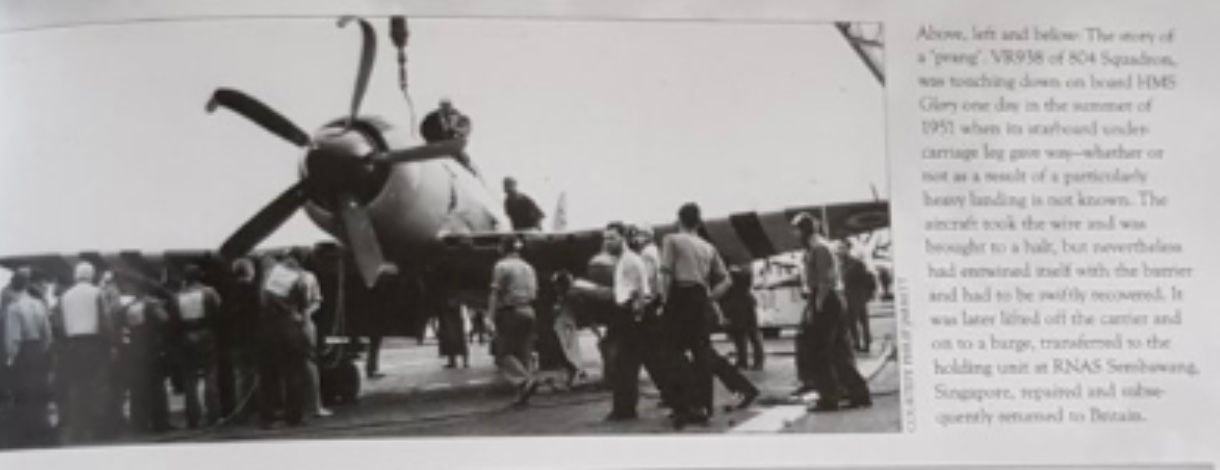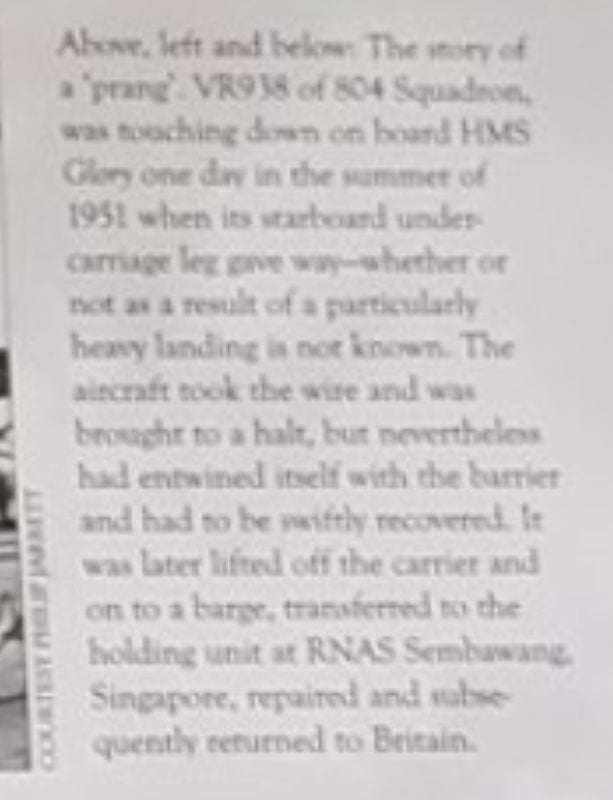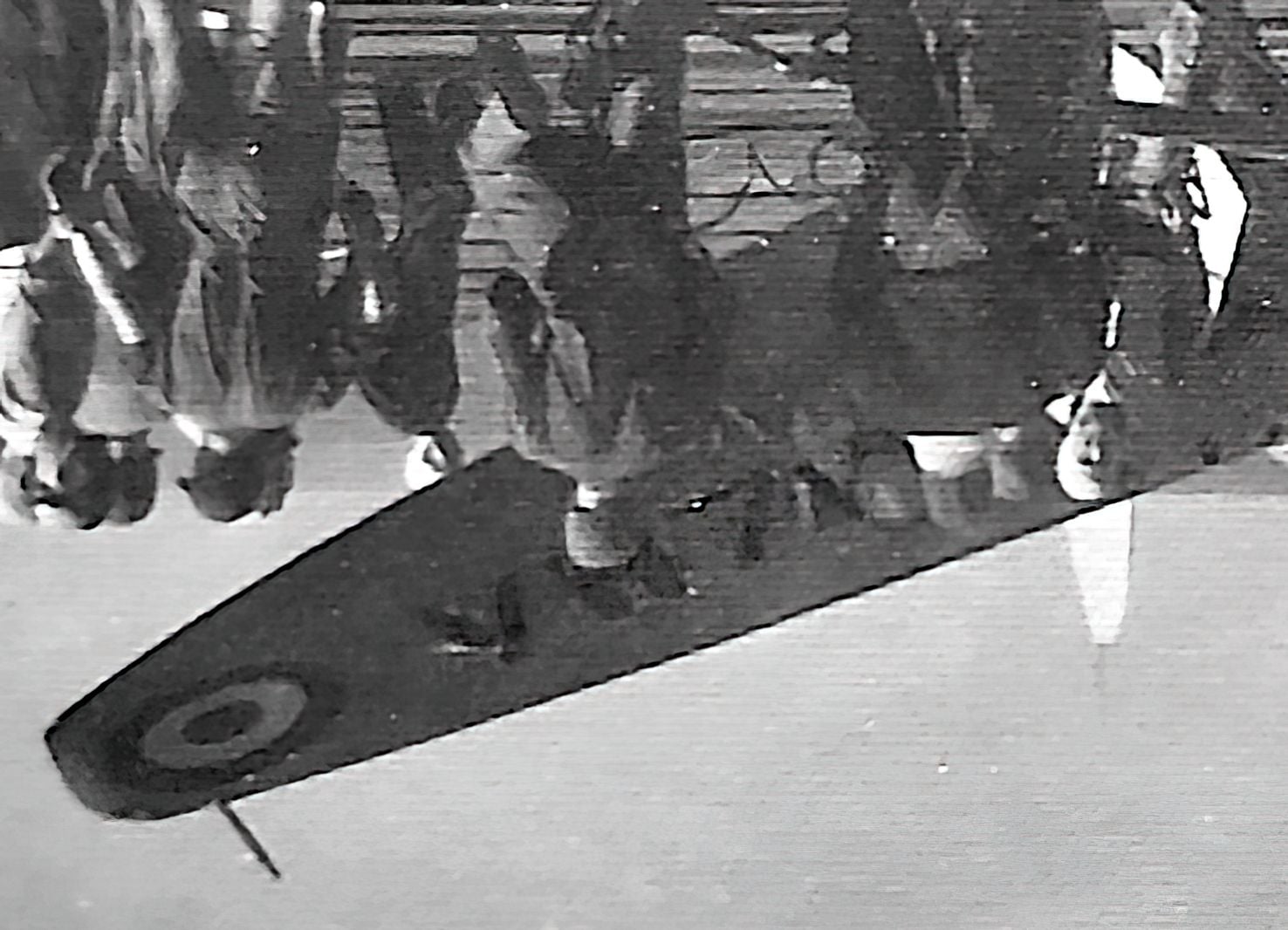mystery sea fury photo
Thread Starter
mystery sea fury photo
I found this photo, from the middle to late 40s I'm guessing, in amongst mum's hundreds of photos. As far as I know we've had no connection with carrier operations, aircrew or ships crew so I've no idea where this came from, which carrier etc. It would be interesting to find out. It looks like a Hawker Sea Fury but where when and what ship? I can make out VH under the wing. It obviously couldn't be an Australian civil reg.
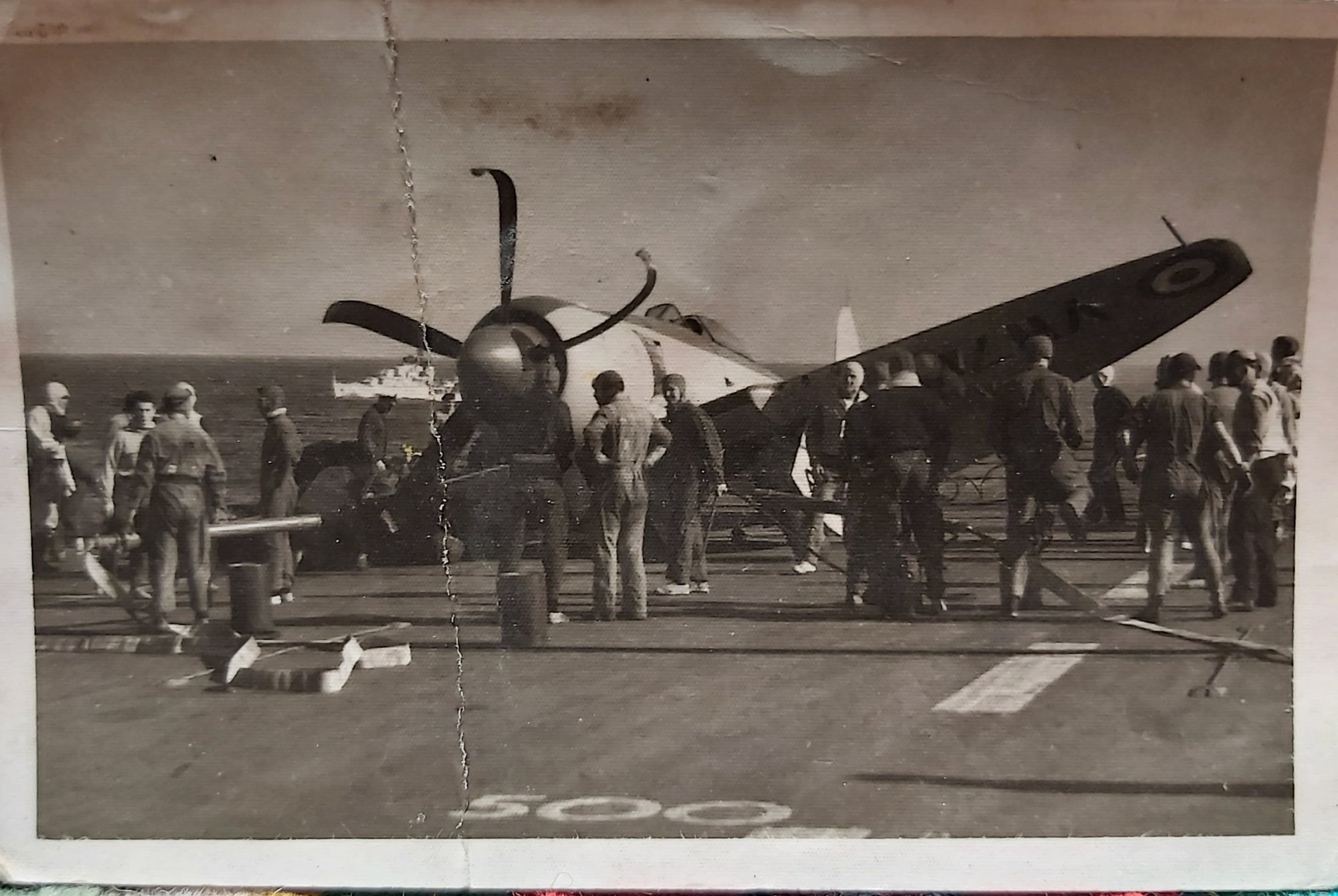

Gnome de PPRuNe
Join Date: Jan 2002
Location: Too close to Croydon for comfort
Age: 60
Posts: 12,615
Received 290 Likes
on
158 Posts
VW7** I think it is... VW700-718 were Sea Furies.
Thread Starter
Looks very similar but theyre not the same. On my photo the ac doesn't have the black and white stripes on the wing.
The props look as though they're curled forward which I would think would mean the gear collapsed at a very low speed or even the arrestor was dragging the ac slowly backwards?
The props look as though they're curled forward which I would think would mean the gear collapsed at a very low speed or even the arrestor was dragging the ac slowly backwards?
I can't help with the history part of things but having had a closer look at the reg. may I suggest it's actually VH7 W* maybe?
Thread Starter
I looks like one of the cables broke. You can see one guy holding one end whilst the other is curled up under the ac. The others are stretched straight across the deck.
Gnome de PPRuNe
Join Date: Jan 2002
Location: Too close to Croydon for comfort
Age: 60
Posts: 12,615
Received 290 Likes
on
158 Posts
Aircraft in the VH*** serial range were largely batches of Fireflies, Lancasters, Seafires and Barracudas, most of which appear to have been cancelled orders. No Sea Furies.
Looks very similar but theyre not the same. On my photo the ac doesn't have the black and white stripes on the wing.
The props look as though they're curled forward which I would think would mean the gear collapsed at a very low speed or even the arrestor was dragging the ac slowly backwards?
The props look as though they're curled forward which I would think would mean the gear collapsed at a very low speed or even the arrestor was dragging the ac slowly backwards?
With the Sea Fury FB.11 retiring from service in 1953, I'd be surprised if the accident aircraft was repaired.
Four of the VW71x series Sea Furies are recorded as being written off in service (VW710/712/716/718), with most of the remainder of the VW batch either going to the Australian Navy or being sold back to Hawkers.
Four of the VW71x series Sea Furies are recorded as being written off in service (VW710/712/716/718), with most of the remainder of the VW batch either going to the Australian Navy or being sold back to Hawkers.
Moderator
The first unit to receive the F.B.11was No 802 Squadron at Eglinton in May 1948
Join Date: Feb 2006
Location: UK
Posts: 592
Likes: 0
Received 0 Likes
on
0 Posts
Having just deleted my first post because on second thoughts, I agree that the number will be VW71n.
Consequently searching the National Archive online for VW710-VW719 reveals:
Accident to Sea Fury FB11 VW710 on 7th June 1952
Accident to Sea Fury XI VW711 on 31st March 1950
Accident to Sea Fury FB11 VW718 on 7th September1953
Unfortunately, none of these records are digitised - but they are available at the National Archive in Kew Garden if there's a real desire to follow up and read them.
None of the other serials return any hits.
Consequently searching the National Archive online for VW710-VW719 reveals:
Accident to Sea Fury FB11 VW710 on 7th June 1952
Accident to Sea Fury XI VW711 on 31st March 1950
Accident to Sea Fury FB11 VW718 on 7th September1953
Unfortunately, none of these records are digitised - but they are available at the National Archive in Kew Garden if there's a real desire to follow up and read them.
None of the other serials return any hits.
Why would a Sea Fury, which entered service no earlier than 1948, have invasion stripes on the wings
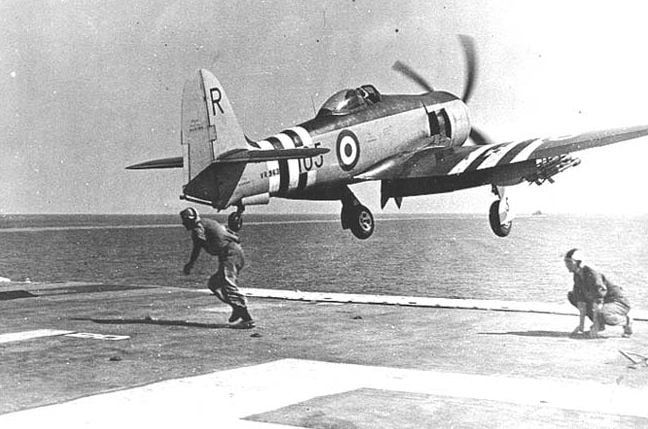
Australian Sea Furys were similarly adorned.
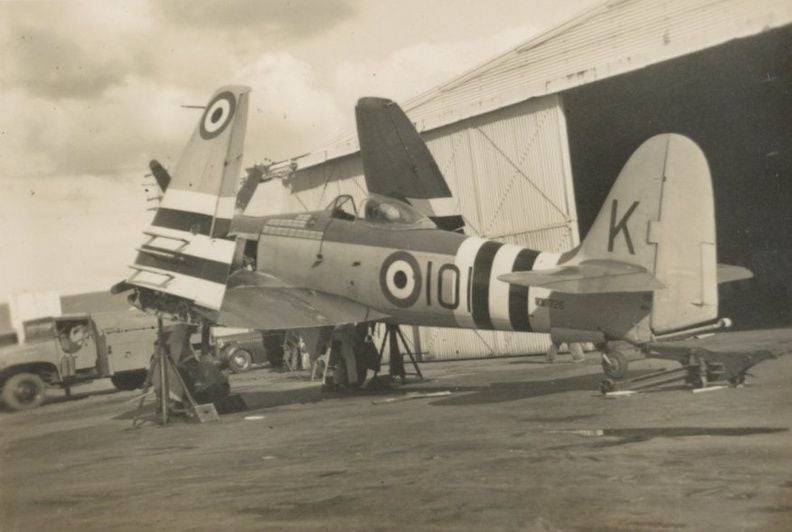
Join Date: Aug 2007
Location: Penang, Malaysia
Age: 78
Posts: 262
Received 0 Likes
on
0 Posts
Interesting photo. Pity there is no code visible on the vertical tail surface. That would help narrow the search down.
The style of dress worn by the deck crew would seem to indicate summertime in the northern hemisphere or the tropics. ‘Chiefy’, visible between the prop blades, has a white top on his cap and what appears to be an officer, just in front of him, looks to be in shirt sleeve order.
The aircraft code on the u/c door mentioned in post #10 might not be a code. I think it could be a handle on a piece of equipment being carried by one of the deck crew standing there.
Of the three accidents mentioned in post #16, it is unlikely to be any of those. The 7 June 52 accident happened on the airfield at Culdrose when the stbd wing folded on take off and the aircraft, VW710, rolled and skidded upside down along the runway.
The incident involving VW711 on 31 March 52 occurred when the aircraft was en route from Vengance to Lee. Engine trouble meant the aircraft force landed. I cannot find a location but would think it unlikely to be the aircraft in the OP’s photo.
The last accident referred to involving VW718, happened near Crail airfield. The aircraft had been practicing RP attacks on the airfield when it came down a short distance to the NNW of the field.
Several other Sea Furies had barrier engagements. Those were:
VW713, serving with 807 NAS aboard HMS Theseus. On 23 March 51, suffered partial engine failure, and caught No.9 wire in an emergency landing with the prop going into the barrier. I believe the ship was at that time in Far Eastern waters.
VW714, served with both 736 and 738 NASs. In July 52, whilst with 736, it caught the No.10 wire and went into the barrier onboard HMS Illustrious. On 4 February 53, the same aircraft, whilst with 738 NAS, bounced on landing and went into the barrier onboard HMS Triumph. Both incidents appear to have been in UK waters.
Lastly, VW717. When with 738 NAS, this aircraft had two barrier engagements in a short space of time. Firstly, on 30 September 53 and then, again, on 30 October 53. Both incidents occurred onboard HMS Triumph in, I think, UK waters.
All info above taken from the excellent Air-Britain book FAA Fixed Wing Aircraft since 1946.
The style of dress worn by the deck crew would seem to indicate summertime in the northern hemisphere or the tropics. ‘Chiefy’, visible between the prop blades, has a white top on his cap and what appears to be an officer, just in front of him, looks to be in shirt sleeve order.
The aircraft code on the u/c door mentioned in post #10 might not be a code. I think it could be a handle on a piece of equipment being carried by one of the deck crew standing there.
Of the three accidents mentioned in post #16, it is unlikely to be any of those. The 7 June 52 accident happened on the airfield at Culdrose when the stbd wing folded on take off and the aircraft, VW710, rolled and skidded upside down along the runway.
The incident involving VW711 on 31 March 52 occurred when the aircraft was en route from Vengance to Lee. Engine trouble meant the aircraft force landed. I cannot find a location but would think it unlikely to be the aircraft in the OP’s photo.
The last accident referred to involving VW718, happened near Crail airfield. The aircraft had been practicing RP attacks on the airfield when it came down a short distance to the NNW of the field.
Several other Sea Furies had barrier engagements. Those were:
VW713, serving with 807 NAS aboard HMS Theseus. On 23 March 51, suffered partial engine failure, and caught No.9 wire in an emergency landing with the prop going into the barrier. I believe the ship was at that time in Far Eastern waters.
VW714, served with both 736 and 738 NASs. In July 52, whilst with 736, it caught the No.10 wire and went into the barrier onboard HMS Illustrious. On 4 February 53, the same aircraft, whilst with 738 NAS, bounced on landing and went into the barrier onboard HMS Triumph. Both incidents appear to have been in UK waters.
Lastly, VW717. When with 738 NAS, this aircraft had two barrier engagements in a short space of time. Firstly, on 30 September 53 and then, again, on 30 October 53. Both incidents occurred onboard HMS Triumph in, I think, UK waters.
All info above taken from the excellent Air-Britain book FAA Fixed Wing Aircraft since 1946.
Join Date: Apr 2008
Location: London
Posts: 91
Likes: 0
Received 0 Likes
on
0 Posts
Gnome de PPRuNe
Join Date: Jan 2002
Location: Too close to Croydon for comfort
Age: 60
Posts: 12,615
Received 290 Likes
on
158 Posts
Weren't similar stripes adopted by French and UK aircraft during the Suez crisis?




